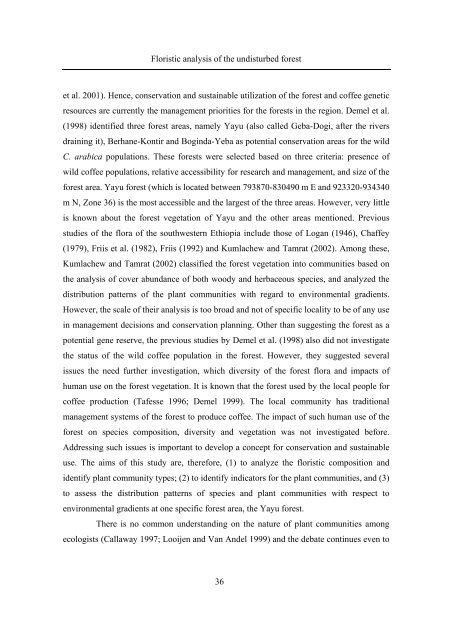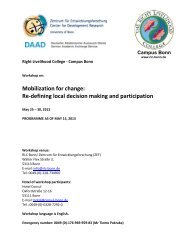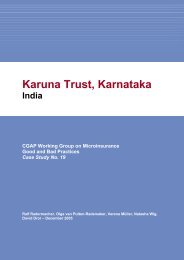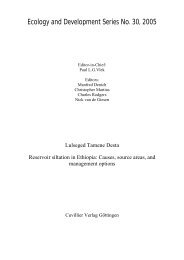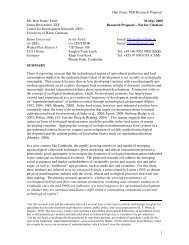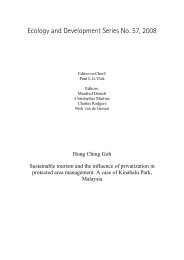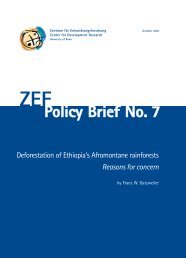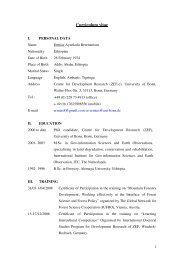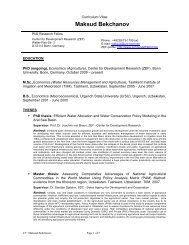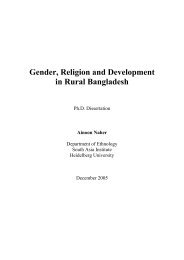Ecology and Development Series No. 10, 2003 - ZEF
Ecology and Development Series No. 10, 2003 - ZEF
Ecology and Development Series No. 10, 2003 - ZEF
- No tags were found...
You also want an ePaper? Increase the reach of your titles
YUMPU automatically turns print PDFs into web optimized ePapers that Google loves.
Floristic analysis of the undisturbed forestet al. 2001). Hence, conservation <strong>and</strong> sustainable utilization of the forest <strong>and</strong> coffee geneticresources are currently the management priorities for the forests in the region. Demel et al.(1998) identified three forest areas, namely Yayu (also called Geba-Dogi, after the riversdraining it), Berhane-Kontir <strong>and</strong> Boginda-Yeba as potential conservation areas for the wildC. arabica populations. These forests were selected based on three criteria: presence ofwild coffee populations, relative accessibility for research <strong>and</strong> management, <strong>and</strong> size of theforest area. Yayu forest (which is located between 793870-830490 m E <strong>and</strong> 923320-934340m N, Zone 36) is the most accessible <strong>and</strong> the largest of the three areas. However, very littleis known about the forest vegetation of Yayu <strong>and</strong> the other areas mentioned. Previousstudies of the flora of the southwestern Ethiopia include those of Logan (1946), Chaffey(1979), Friis et al. (1982), Friis (1992) <strong>and</strong> Kumlachew <strong>and</strong> Tamrat (2002). Among these,Kumlachew <strong>and</strong> Tamrat (2002) classified the forest vegetation into communities based onthe analysis of cover abundance of both woody <strong>and</strong> herbaceous species, <strong>and</strong> analyzed thedistribution patterns of the plant communities with regard to environmental gradients.However, the scale of their analysis is too broad <strong>and</strong> not of specific locality to be of any usein management decisions <strong>and</strong> conservation planning. Other than suggesting the forest as apotential gene reserve, the previous studies by Demel et al. (1998) also did not investigatethe status of the wild coffee population in the forest. However, they suggested severalissues the need further investigation, which diversity of the forest flora <strong>and</strong> impacts ofhuman use on the forest vegetation. It is known that the forest used by the local people forcoffee production (Tafesse 1996; Demel 1999). The local community has traditionalmanagement systems of the forest to produce coffee. The impact of such human use of theforest on species composition, diversity <strong>and</strong> vegetation was not investigated before.Addressing such issues is important to develop a concept for conservation <strong>and</strong> sustainableuse. The aims of this study are, therefore, (1) to analyze the floristic composition <strong>and</strong>identify plant community types; (2) to identify indicators for the plant communities, <strong>and</strong> (3)to assess the distribution patterns of species <strong>and</strong> plant communities with respect toenvironmental gradients at one specific forest area, the Yayu forest.There is no common underst<strong>and</strong>ing on the nature of plant communities amongecologists (Callaway 1997; Looijen <strong>and</strong> Van Andel 1999) <strong>and</strong> the debate continues even to36


